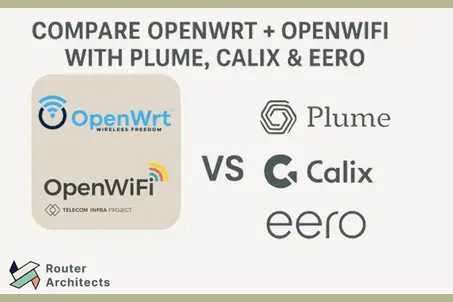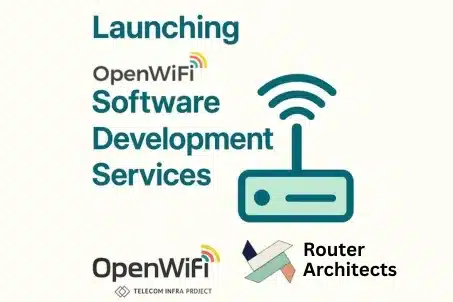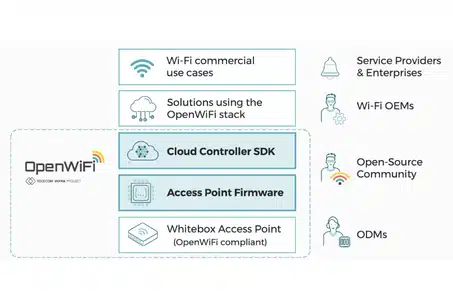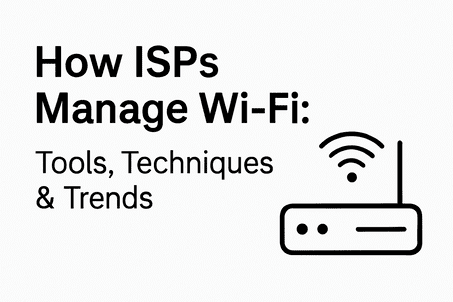In today’s hyper-connected homes, residential ISPs play a pivotal role in delivering seamless internet experiences. But delivering consistent, high-performance Wi-Fi isn’t just about plugging in a router—it requires a sophisticated combination of hardware, software, cloud management, and increasingly, AI-driven intelligence.
Let’s take a closer look at the different ways residential ISPs manage their Wi-Fi networks, and how modern, open-source alternatives are transforming the landscape.
1. Powering Routers with Modern Firmware
ISPs typically deploy customer-premises equipment (CPE) such as home routers that run on robust firmware stacks. These include both proprietary and open-source platforms:
-
OpenWrt – A highly customizable Linux-based firmware ideal for advanced users and ISPs looking to tailor features.
-
OpenSync – Enables cloud-based control and multi-device synchronization, commonly used with Plume.
-
OpenWiFi – A Telecom Infra Project (TIP) initiative promoting fully open-source, cloud-managed Wi-Fi.
-
RDK-B – An open-source broadband stack built for large-scale deployment by MSOs and telcos.
These platforms allow for granular control over Wi-Fi parameters, remote diagnostics, and integration with cloud systems.
2. Centralized Management with Cloud Platforms
To scale operations, ISPs increasingly turn to cloud-based Wi-Fi management platforms. These platforms offer:
🔧 For ISPs:
-
Device Provisioning: Automate router onboarding.
-
Remote Configuration: Update SSID, radio channels, encryption, and more from a central dashboard.
-
WAN/LAN Management: Control internet gateway settings remotely.
-
Firmware Upgrades: Push updates without requiring customer intervention.
-
Mesh Networking Support: Configure and monitor mesh topologies.
-
Real-Time Monitoring: View connected devices, data usage, and signal quality in real-time.
🧑💻 For End Users:
-
Self-Care Portals: Let customers customize SSID, manage devices, or configure guest networks.
-
Parental Controls: Enable time-based or content-based device restrictions.
-
Performance Dashboards: View network health and bandwidth consumption.
Such systems reduce customer support costs, improve user satisfaction, and enable proactive service management.
3. OSS/BSS Integration for Seamless Operations
To maintain efficient business workflows, ISPs integrate Wi-Fi management platforms with their Operational Support Systems (OSS) and Business Support Systems (BSS). This enables:
-
Automated provisioning
-
Billing integration
-
Service activation
-
Fault detection and ticketing
APIs are used to ensure smooth data flow between systems, reducing manual effort and errors.
4. Smarter Networks with AI-Driven Optimization
Advanced ISPs are going beyond traditional management with AI-powered agents that:
-
Dynamically select the best Wi-Fi channel by analyzing interference and congestion
-
Predict future network issues based on usage trends and environmental data
-
Automatically switch channels and monitor performance post-change
-
Provide self-healing capabilities that reduce downtime and customer complaints
This intelligent automation improves reliability and eliminates the need for reactive troubleshooting.
5. Moving Away from Proprietary Lock-in
While platforms like Plume offer compelling features, they come with licensing costs and limited customization. Forward-looking ISPs are now embracing vendor-neutral, open-source solutions to:
-
Lower operational costs
-
Gain flexibility and full control over the customer experience
-
Avoid vendor lock-in
-
Customize features for specific regional or demographic needs
Solutions built using OpenWrt, OpenWiFi, and open-source cloud stacks provide a scalable and cost-effective alternative, especially when backed by expert partners.
6. Unlocking New Revenue Streams
Beyond connectivity, ISPs are exploring value-added services such as:
-
VPNs for remote workers and travelers, enabling secure and unrestricted browsing
-
Enhanced security and parental control features that cater to families
-
Premium support packages for high-bandwidth users or gamers
These services not only improve customer retention but also diversify revenue.
Conclusion: The Future is Open, Smart, and Cloud-Driven
Residential Wi-Fi is no longer a “plug and play” experience. Behind the scenes, ISPs are leveraging powerful tools to configure, monitor, and optimize home networks in real time. By embracing open-source platforms, cloud-based management, and AI-driven intelligence, they can reduce costs, improve service quality, and future-proof their networks.
Are you an ISP looking to upgrade your Wi-Fi management strategy?
Router Architects offers vendor-neutral, open-source solutions that deliver enterprise-grade performance—without the enterprise cost.





